![]()
![]()
![]()
Use LEFT and RIGHT arrow keys to navigate between flashcards;
Use UP and DOWN arrow keys to flip the card;
H to show hint;
A reads text to speech;
7 Cards in this Set
- Front
- Back
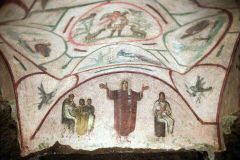
#48 |
T: Catacomb of Priscilla A: Unknown D: c. 200-400 C.E. M/D: Excavated tufa and fresco P/S: Late Antique Europe OL: Rome, Italy P: N/A F: Christian burials DT: Symmetry, Catacomb, opulent interior C: Has the world's oldest known image of Mary depicting her nursing baby Jesus |
|
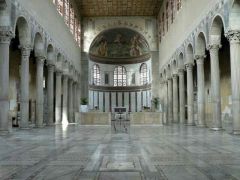
#49 |
T: Santa Sabina A: Unknown D: c. 422-432 C.E. M/D: Brick and stone, wooden roof P/S: Late Antique Europe OL: Rome, Italy P: Peter of Illyria F: A titular minor basilica and mother church of the Roman Catholic Order of Preachers DT: Austere Exterior, Opulent Interior, C: The oldest extant Roman basilica in Rome that preserves its original colonnaded rectangular plan and architectural style |
|
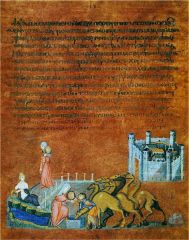
#50 |
T: Rebecca and Eliezer at the Well and Jacob Wrestling the Angel A: Saint Hildegard von Bingen D: Early sixth century C.E. M/D: Illuminated manuscript (tempera, gold, and silver on purple vellum) P/S: Early Byzantine Europe OL: Vienna Genesis P: Unknown F: To describe a fragment of a Greek copy of the Book of Genesis in more detail DT: Depiction, storytelling, C: The oldest surviving well-preserved illustrated biblical book and an excellent example of an artist caught in a moment of transition |
|
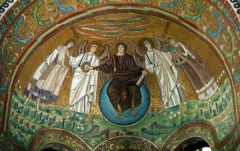
#51 |
T: San Vitale A: Unknown D: c. 526-547 C.E. M/D: Brick, marble, and stone veneer; mosaic P/S: Early Byzantine Europe OL: Ravenna, Italy P: Julianus Argentarius, Justinian, F: Religious DT: Octagon shape, ambulatory, gallery, alabaster paned windows, C: Named after Saint Vitale, |
|

#52 |
T: Hagia Sophia A: Anthemius of Tralles and Isidorus of Miletus D: 532-537 C.E. M/D: Brick and ceramic elements with stone and mosaic veneer P/S: Early Europe OL: Constantinople (Istanbul), Turkey P: Justinian F: church/worship DT: Dome, Buttresses and minarets were added later, C: Biggest Christian Church in that era, Nave for clergy, congregation separated by Sex, ceremonies, |
|
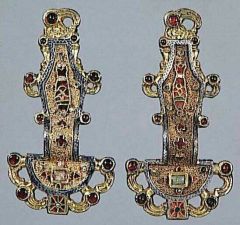
#53 |
T: Merovingian looped fibulae A: Unknown D: Mid-sixth century C.E. M/D: Silver gilt worked in filigree, with inlays of garnets and other stones P/S: Early medieval Europe OL: Unknown P: Unknown F: A Brooch DT: Specific, unique, inlaid C: Fibulae are brooches that were made popular by Roman military campaigns |
|
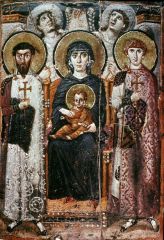
#54 |
T: Virgin (Theotokos) and Child between Saints Theodore and George A: Unknown D: Sixth or early seventh century C.E. M/D: Encaustic on wood P/S: Early Byzantine Europe OL: Unknown P: Unknown F: To provide a visual movement inward and upward, from the saints to the Virgin and from the Virgin upward past the angels to the hand of God DT: Classicizing, C: The viewer who stands before the scene make this cosmos complete, from “our earth” to heaven |

